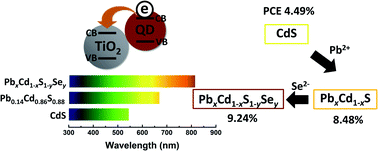Band gap tunable quaternary PbxCd1−xS1−ySey quantum dot-sensitized solar cells with an efficiency of 9.24% under 1% sun
Abstract
We present a new solar absorber material – quaternary PbxCd1−xS1−ySey quantum dots (QDs) – with a band gap Eg tunable over a broad range of 1.5–2.4 eV. PbxCd1−xS1−ySey QDs were prepared using a two-step cation/anion co-alloying approach: first, Pb2+ was incorporated into the binary CdS host by cation exchange, leading to ternary PbxCd1−xS QDs. Second, Se2− replaced a fraction of S2− in PbxCd1−xS by anion exchange, leading to quaternary PbxCd1−xS1−ySey QDs. The reactions reduced the Eg from 2.42 (CdS, absorption onset 500 nm) to 1.91 (PbxCd1−xS, 650 nm) to 1.55 eV (PbxCd1−xS1−ySey, 800 nm). The Eg of PbxCd1−xS1−ySey (1.55 eV) is close to the Shockley–Queisser gap. Solid-state PbxCd1−xS1−ySey QD solar cells (QDSCs) were fabricated with Spiro-OMeTAD as the hole transport material. The best cell (Pb0.15Cd0.85S0.75Se0.18) yielded Jsc = 13.71 mA cm−2, Voc = 0.59 V, FF = 54.8% and PCE = 4.43% under 1 sun. At low light intensities, the PCE increased to 7.18% under 10% sun and further to 9.24% under 1% sun. The co-alloying treatment improved the PCE from 4.49 (CdS) to 8.48 (PbxCd1−xS) to 9.24% (Pb0.15Cd0.85S0.75Se0.18) under 1% sun. The cell with a PCE of 9.24% can be categorized as a high-efficiency QDSC, suggesting that PbxCd1−xS1−ySey can be an efficient solar absorber.



 Please wait while we load your content...
Please wait while we load your content...